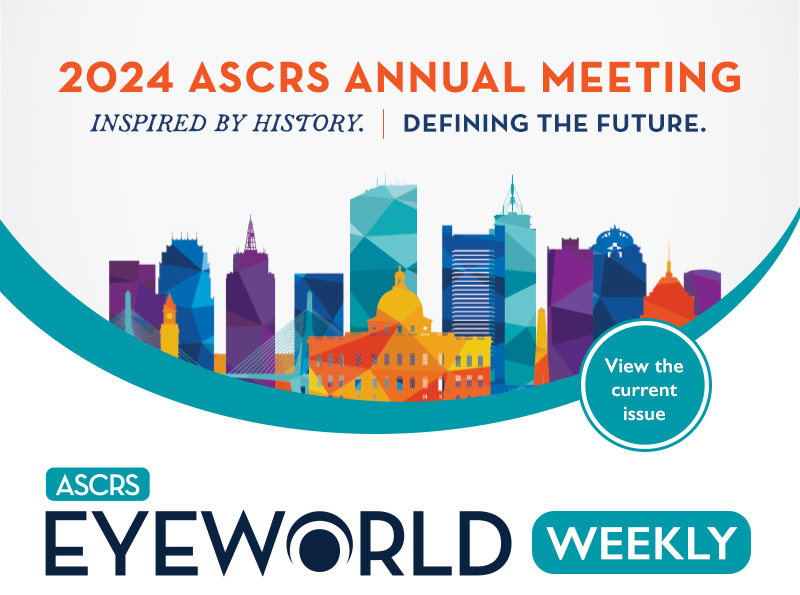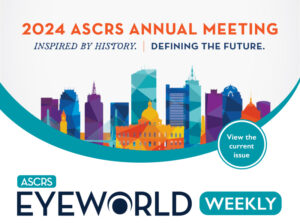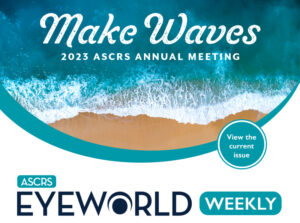
- FDA clears fully autonomous, portable AI device for diabetic retinopathy screening
- Positive preliminary data for Phase 1/2 trial evaluating gene therapy treatment for X-linked retinoschisis
- Dosing in Phase 1/2 trial for allogenic cell therapy for corneal edema
- Dosing complete in trial assessing corneal edema therapy
- Phase 4 results for mydriasis product reported
- Collaboration seeks to commercialize Alzheimer’s detection through retinal imaging
- ASCRS news and events
May 3, 2024 • Volume 30, Number 18
FDA clears fully autonomous, portable AI device for diabetic retinopathy screening
AEYE Health announced that it received FDA clearance for its fully autonomous AI system that detects referable diabetic retinopathy. According to the company’s press release, this is a first-ever approval from the FDA for such a technology, which obtains images from a handheld camera and provides point-of-care screening capabilities. The company’s tabletop version (AEYE Diagnostic Screening) already received FDA approval. This new approval uses the Optomed Aurora portable device. The handheld imaging system and AI technology showed diagnostic sensitivity between 92–93% and specificity between 89–94%. The company also noted that the diagnostic result was produced from a single image of each eye and rarely required dilation.
Positive preliminary data for Phase 1/2 trial evaluating gene therapy treatment for X-linked retinoschisis
Atsena Therapeutics announced positive data from its first cohort participating in a Phase 1/2 trial for ATSN-201 gene therapy to treat X-linked retinoschisis. According to the company’s press release, this low-dose cohort showed 2 out of 3 patients with “extensive resolution of schisis” 8 weeks after dosing, with continued resolution of schisis observed through week 24. The press release noted that the areas of schisis resolution were inside and outside the subretinal injection blebs, which “[indicates] that the AAV.SPR is spreading laterally from the injection blebs.” From a functional standpoint, the press release reported improvements of up to 14 dB in one patient (38 loci showed improvement of 7 dB or greater). The FDA, according to the company, considers at least 7 dB at 5 or more loci to be clinically meaningful. The therapy was well tolerated with no serious adverse events. The second (mid-dose) cohort has begun dosing.
Dosing in Phase 1/2 trial for allogenic cell therapy for corneal edema
Aurion Biotech announced that it has completed dosing in all subjects for its Phase 1/2 study evaluating the allogenic cell therapy (AURN001) for treatment of corneal edema secondary to corneal endothelial dysfunction. According to the company’s press release, the study is prospective, multi-center, randomized, double masked, parallel arm cell dose-ranging. It is evaluating three doses of neltependocel in combination with Y-27632, which the company described as “an inhibitor of Rho-associated, coiled-coil containing protein kinase (ROCK).” The therapy is designed to be a one-time intracameral injection.
Dosing complete in trial assessing corneal edema therapy
Emmecell announced that it has completed dosing of its last patient in the randomized, double-masked, multi-center U.S. trial assessing safety and efficacy of EO2002 for treatment of corneal edema. This, according to the company, is a first-in-class, non-surgical cell therapy that uses the proprietary Magnetic Cell Delivery, a nanotechnology platform, that could help avoid corneal transplantation. Topline results are expected in the second half of this year with a Phase 3 pivotal trial targeted for the first quarter of 2025.
Phase 4 results for mydriasis product reported
Eyenovia announced Phase 4 results of its FDA approved Mydcombi mydriasis product, which sought to determine efficacy and duration of its lowest dose. According to the company’s press release, 29 participants were treated with a half dose of Mydcombi (8 microliters of tropicamide and phenylephrine hydrochloride ophthalmic spray 1%/2.5%, per eye). Investigators found that 30 minutes after dosing, 67% of participants achieved clinically relevant pupil dilation and 86% by 60 minutes. Most patients’ pupils (93%) returned to normal size between 3.5 and 6 hours post-instillation.
Collaboration seeks to commercialize Alzheimer’s detection through retinal imaging
Topcon and RetiSpec announced a collaboration to bring what is currently a technology used for research only to the commercial market. According to the press release, RetiSpec’s AI-powered technology helps detect an Alzheimer’s biomarker before symptoms, which could allow for earlier disease detection through retinal imaging.
ASCRS news and events
- ASCRS Live!: This new dinner series, making its way to nine cities, is continuing to bring ASCRS education around the U.S. See where it’s heading next.
- ASCRS 50th Anniversary: Review historical videos, watch member accounts, and scroll through the timeline—all brought together on these webpages to celebrate the Society’s historic anniversary.
- ASCRS Annual Meeting: Hotel blocks are open for the 2025 ASCRS Annual Meeting in Los Angeles, California, April 25–28, 2025.
Research highlights
- The use of a modified scleral pocket vs. no scleral pocket for intrascleral IOL fixation was described in a prospective, randomized, single-surgeon observational study published in the Journal of Cataract & Refractive Surgery. Thirty-six total eyes of 36 patients who were aphakic with no capsular support were randomized to receive intrascleral haptic fixation with the double-needle flanged technique first described by Shin Yamane, MD, PhD, or intrascleral haptic fixation with a modified scleral pocket technique (18 eyes in each group). At 1, 3, 6, and 12 months, AS-OCT was used to measure flange depth. At 12 months, UCDVA and CDVA were not statistically different between the two groups. AS-OCT, however, revealed a significantly deeper flange position in the group with the modified scleral pocket at all time points evaluated.
- The safety of a commercially available intracameral mydriatic and anesthetic compared to a topical mydriatic regimen for cataract surgery was evaluated in a paper published in Clinical Ophthalmology. The results from two international, randomized, controlled studies were compiled to compare the two treatments. There were 342 patients who received the intracameral mydriatic/anesthetic and 318 who received the topical regimen. Adverse events were reported in 17.0% in the intracameral group and 18.6% in the topical/reference group. There was no difference in endothelial cell density or retinal thickness at 1 month postop between the two groups. On day 1 postop, there were fewer patients in the intracameral group who had moderate or severe superficial punctate corneal staining compared to the reference group (3.9% vs. 7.0%, respectively). Ocular symptoms were also less frequently reported in the intracameral group, according to the authors. At 1 month postop, BCVA increased 96.0% in the intracameral group and 95.8% in the reference group. The authors concluded that intracameral mydriasis and anesthetic was safe and could provide peri- and postoperative advantages over a standard topical mydriatic regimen.
This issue of EyeWorld Weekly was edited by Stacy Jablonski, Liz Hillman, and Ellen Stodola.
EyeWorld Weekly (ISSN 1089-0319), a digital publication of the American Society of Cataract and Refractive Surgery (ASCRS), is published every Friday, distributed by email, and posted live on Friday.
Medical Editors: Sumit “Sam” Garg, MD, Chief Medical Editor, Mitchell Weikert, MD, Cataract Editor, Karolinne Rocha, MD, PhD, Refractive Editor, Julie Schallhorn, MD, Cornea Editor, Manjool Shah, MD, Glaucoma Editor
For sponsorship opportunities or membership information, contact: ASCRS • 12587 Fair Lakes Circle • Suite 348 • Fairfax, VA 22033 • Phone: 703-591-2220 • Fax: 703-591-0614 • Email: ascrs@ascrs.org
Mention of products or services in EyeWorld Weekly does not constitute an endorsement by ASCRS.
Click here to view our Legal Notice.
Copyright 2024, EyeWorld News Service. All rights reserved.



